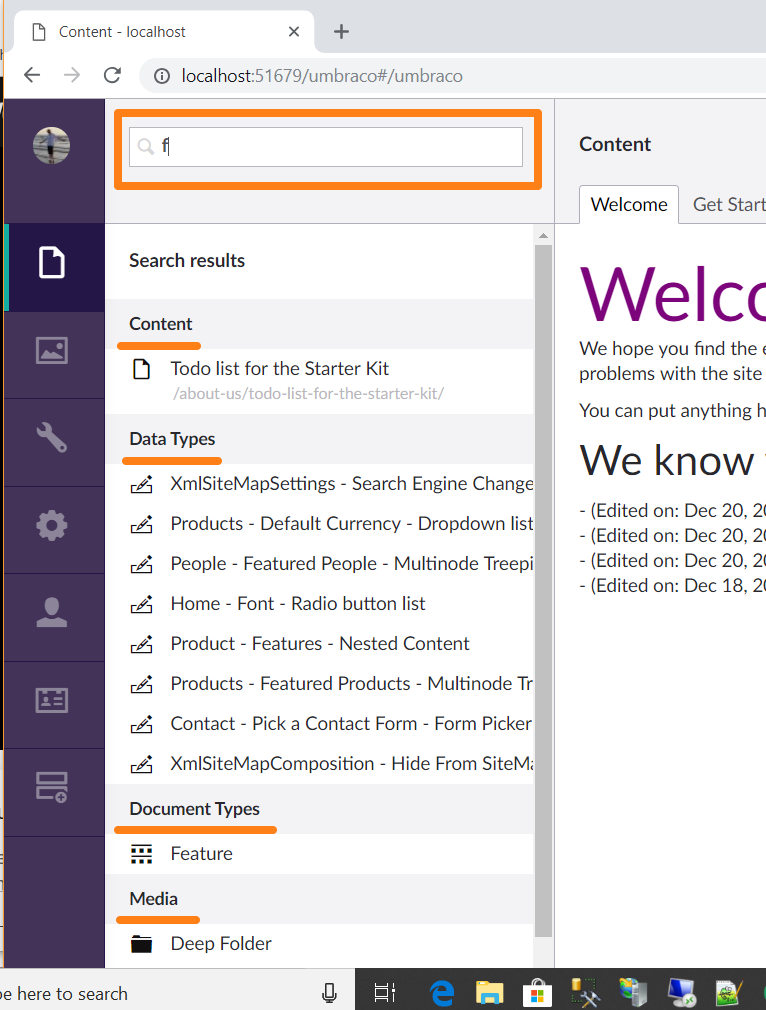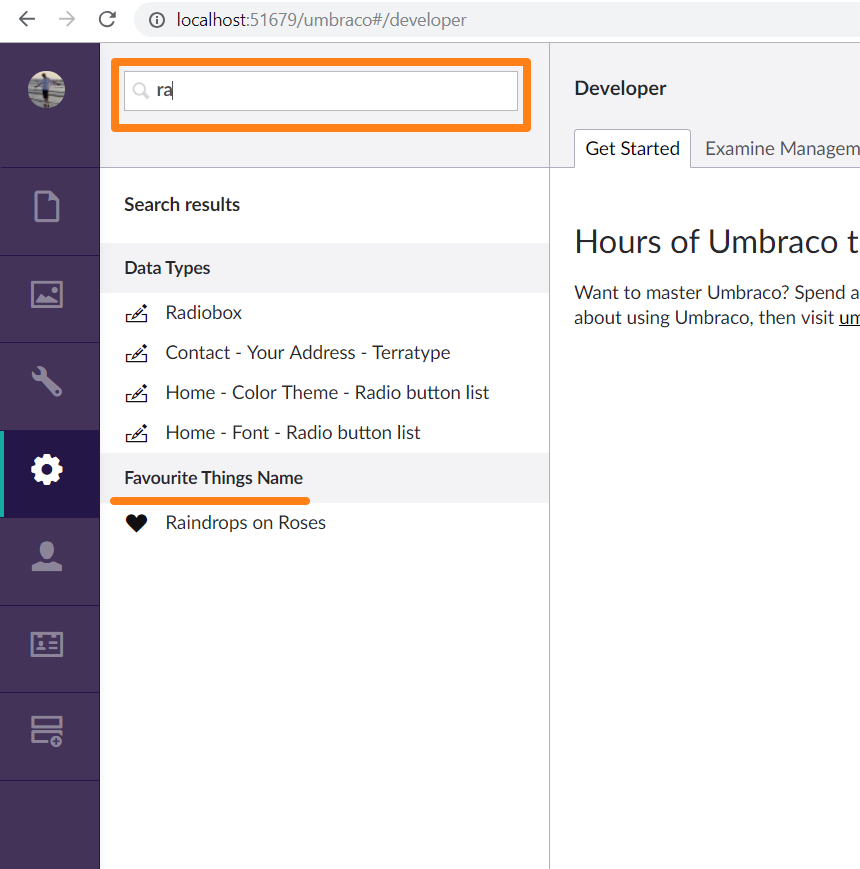Searchable Trees (ISearchableTree)
When you type a search term into the Umbraco backoffice search field, you'll see search results from all the Section Trees that your user account has permissions to access:

The results are grouped by 'Section Tree' e.g. Content, Media, Document Types: essentially, each 'Tree' has its own associated search mechanism that receives the search term and looks for matches in the tree that is responsible for searching.
You can create your own search mechanisms for your own custom sections or replace the default search implementation for a particular section tree.
Custom Tree Search
To create a search for your own custom tree you need to create a C# class that implements the interface Umbraco.Web.Search.ISearchableTree
ISearchableTree
public interface ISearchableTree
{
//
// Summary:
// The alias of the tree that the Umbraco.Web.Search.ISearchableTree belongs to
string TreeAlias { get; }
//
// Summary:
// Searches for results based on the entity type
// Parameters:
// query:
// pageSize:
// pageIndex:
// totalFound:
// searchFrom:
// A starting point for the search, generally a node id, but for members this is
// a member type alias
IEnumerable<SearchResultItem> Search(string query, int pageSize, long pageIndex, out long totalFound, string searchFrom = null);
}
Your implementation needs to return an IEnumerable of SearchResultItem items:
public class SearchResultItem : EntityBasic
{
public SearchResultItem();
//
// Summary:
// The score of the search result
[System.Runtime.Serialization.DataMemberAttribute(Name = "score")]
public float Score { get; set; }
}
A SearchResultItem consists of a Score (a Float value) identifying its relevance to the search term, and the set of EntityBasic properties that all Umbraco objects share: eg Name, Id, Udi, Icon, Trashed, Key, ParentId, Path, Alias, AdditionalData
Example implementation of ISearchableTree
If we have a custom section Tree with alias 'favouriteThingsAlias' (see the custom tree example) then we could implement searchability by creating the following c# class in our site:
public class FavouriteThingsSearchableTree : ISearchableTree
{
public string TreeAlias => "favouriteThingsAlias";
public IEnumerable<SearchResultItem> Search(string query, int pageSize, long pageIndex, out long totalFound, string searchFrom = null)
{
// your custom search implementation starts here
Dictionary<int, string> favouriteThings = new Dictionary<int, string>();
favouriteThings.Add(1, "Raindrops on Roses");
favouriteThings.Add(2, "Whiskers on Kittens");
favouriteThings.Add(3, "Skys full of Stars");
favouriteThings.Add(4, "Warm Woolen Mittens");
favouriteThings.Add(5, "Cream coloured Unicorns");
favouriteThings.Add(6, "Schnitzel with Noodles");
var searchResults = new List<SearchResultItem>();
var matchingItems = favouriteThings.Where(f => f.Value.StartsWith(query, true, System.Globalization.CultureInfo.CurrentCulture));
foreach (var matchingItem in matchingItems)
{
searchResults.Add(new SearchResultItem() { Id = 12345, Alias = "favouriteThingItem", Icon = "icon-favorite", Key = new Guid("325746a0-ec1e-44e8-8f7b-6e7c4aab36d1"), Name = matchingItem.Value, ParentId = -1, Path = "-1,123456", Score = 1.0F, Trashed = false });
}
// set number of search results found
totalFound = matchingItems.Count();
// return your IEnumerable of SearchResultItems
return searchResults;
}
}
That's all we need, after an application pool recycle, if we now search in the backoffice we'll see matches from our custom 'Favourite Things' tree:

Umbraco automatically finds any implementation of ISearchableTree in your site, and automatically configures it to be used for the custom section mentioned in the TreeAlias property. Be careful not to accidentally have two ISearchableTree implementations trying to search the 'same' TreeAlias, its 'one ISearchableTree per TreeAlias'!
Replacing an existing Section Tree Search (SearchableTreeResolver)
Perhaps you want to change the logic for searching an existing section of the site, (why? - well you might have a 'company name' property on a MemberType in the Member section, and you want searches for that company name to filter the members who work there, the default implementation will only search on Member Name).
Or perhaps you want to replace Examine search in the backoffice with an external Search Service, eg Azure Search. In a cloud hosted implementation you don't need to build the Examine indexes on each new server as your cloud hosting scales out.
Example
First create your replacement custom ISearchableTree implementation, using the same approach as above, but specifying the TreeAlias of the Tree you aim to replace, eg 'Member'
public string TreeAlias => "member";
To avoid your custom implementation clashing with the default ISearchableTree for a Tree, you need to remove its ISearchableTree implementation by Type at 'ApplicationStarting' using the SearchableTreeResolver:
public class ApplicationStartUp : ApplicationEventHandler
{
protected override void ApplicationStarting(UmbracoApplicationBase umbracoApplication, ApplicationContext applicationContext)
{
//Remove the existing ISearchableTree implementation for the Member Tree
SearchableTreeResolver.Current.RemoveType<MemberTreeController>();
}
}
This would then allow your custom implementation of ISearchableTree with TreeAlias 'Member' to be used when searching the Member Section Tree.